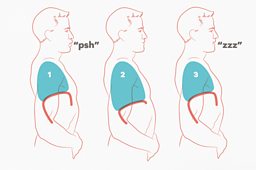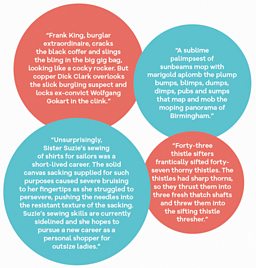Five steps to get a must-listen voice
To make your voice sound interesting you need good breath support and effective articulation. Radio 4's Word of Mouth has been talking to vocal consultants Dr Gillyanne Kayes and Jeremy Fisher.
Here are five of the voice training exercises from their book This Is A Voice, published by Wellcome Collection. Illustrations by Bret Syfert.
1. The most efficient breathing technique
The voice needs breath to power its sound. The diaphragm, the principal muscle for breathing in, will contract more efficiently if your abdominal wall is released on the in-breath. This will allow breath to be drawn deeper into the lungs. Use this three-step exercise to make your abdomen move slightly when you breathe in and out:
1. Put your thumb on your navel and the rest of the hand lower down. Make a strong “psh!” sound, then elongate it: “pshhhhhhhh”. As you make the sound, move your navel inwards. This “feeds” the air in and upwards towards your vocal folds.
2. When you have run out of air, allow your navel to release outwards to take the air in again. This moves the abdominal contents (viscera) down and out slightly, allowing the bottom of the lungs to move down and helping the air to rush in and down.
3. Now repeat on a voiced sound such as “zzz” or “vvv” – it’s the same action but this time you’re adding vibration from your vocal folds.

2. Releasing jaw tension
A tense jaw can lead to tightness further down in the throat. This massaging and chewing exercise will help to release jaw tension and also make you aware of some of your resonating spaces.
1. Massage your cheeks with your knuckles. Take particular care with the area under your cheekbones because this is where most of your jaw tension will be.
2. Now stop the massaging and chew for 20 seconds with your lips open – not just up and down, use a circular motion. Don’t open the jaw too wide, you just need to move the muscles.
3. Keep chewing, close your lips and hum.
4. Keep chewing and humming, and put your fingers in your ears. You will hear the resonance moving around inside your head as you chew.
5. Keep chewing, take your fingers out of your ears and speak a sentence or read aloud. You might find it tricky to start with, or even sounding a little odd, but the chewing separates your jaw, tongue and lips for better diction.
6. Stop the chewing and speak the sentence again. Your voice will sound freer, with the feeling of more space inside your mouth.
3. Toothbrush talk
Many people use their jaw, tongue and lips as one unit, which isn’t using your mouth to its full potential. This exercise helps you to separate your lips and tongue movements from your jaw movements.
1. Put a toothbrush (or a finger) in one side of your mouth and hold it steady with your back teeth.
2. Say the vowel sounds “oo”, “ah” and “eh”. Your lips and tongue can move to create the vowels, but the toothbrush must stay still.
3. Start speaking. Keep the jaw still and the toothbrush steady – don’t bite. If the toothbrush moves up and down, you are using your jaw to speak.
4. Repeat with the toothbrush on the other side of your jaw.
5. Repeat with the toothbrush held with your front teeth only.

4. Warming up your articulators
Clear articulation of consonants is an important part of good speaking and singing. By using this routine to work the tongue, soft palate and lips you can warm up those parts of your mouth that shape the sounds of speech.
1. Whisper these three separate sounds: “p, t, k”.
2. Concentrate on the lips (p), the tip of the tongue (t) and the back of the tongue (k) making contact to produce the sounds.
3. Whisper each sound three times – “p, p, p” – “t, t, t” – “k, k, k”. Make the movements of the articulators as efficient as possible. Don’t over-open the jaw and keep your cheeks soft, massaging them with your knuckles to make sure you are not tensing.
4. Now say “p, t, k” aloud three times.
5. Reverse the order and repeat three times “k, t, p”.
6. Say “p, t, k, k, t, p” three times.

5. Consonant awareness
Clearly articulated consonants are important cues for a listener and will be more intelligible if made louder or longer. Making them longer gives a smoother sound and allows your audience more time to hear and understand what you are saying. This exercise enables you to experiment with each of these ways.
1. Speak one of the four sample paragraphs [below] and use volume and emphasis to kick some of the key consonants. For example, emphasise any plosive sounds – “b”, “p”, “d”, “t”, “g” and the hard “c” (k) – at the beginning of words.
2. Repeat step 1 and speed up the paragraph, but continue to kick the key consonants.
3. The key consonants in the second paragraph [below] are fricatives (“f”, “v”, “sh” and “th”). Say the paragraph slowly and, using the same volume throughout, dwell lovingly on the key consonants.
“Ffforty-thththree thththistle sifffters fffrantically sifffted ffforty-sevvven thththorny thththistles. The thththistles had shshsharp thththorns, so thththey thththrust thththem into thththree fffreshshsh thththatchchch shshshafffts and thththrew thththem into the sifffting thththistle thththreshshsher”
Fricatives use a lot of breath, so remember to breathe as often as you need to. By lengthening the key consonants you will become more aware of the articulators you are using to make them.
4. Repeat step 3 and speed up the paragraph, but continue to dwell on the key consonants.
5. Choose any paragraph from the four below and explore alternating between louder or longer consonants to give variety.

For more information about This Is A Voice, see Dr Gillyanne Kayes' and Jeremy Fisher's voice training website.
Find out more about This Is A Voice and Wellcome Collection.
-
![]()
Word of Mouth
Vocal coaches Gillyanne Kayes and Jeremy Fisher give Michael Rosen a thorough workout.
-
![]()
The apostrophe quiz!
Are you grammatically gormless or a punctuation perfectionist? Find out now.
-
![]()
Seven of your biggest grammar bugbears sorted
Clearing up the top grammar gripes, queries and common mistakes.
-
![]()
Smiley face: Seven things you didn't know about emoji
Which nation favours the poo emoji? Here are some fascinating emoji facts.




